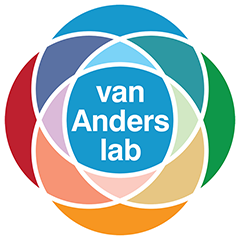Feminist & Queer Science
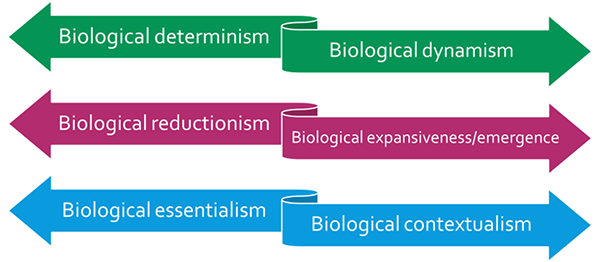
All our work is conducted using a feminist science lens, meaning
that attending to inequities related to gender and intersecting
identities is fundamental to our research projects. We also
situate our work within a queer science approach, meaning that
we see our work as expanding, opening, and transforming
possibilities, categories, and understandings about intimacies,
gender/sex, and biologies in plural ways. Feminist and queer
science happens at all levels, from lab meetings to writing
papers, from theory to method, and more. Some of our work is
explicitly about feminist/queer science methodologies, while some of
our work is built upon a feminist/queer science framework.
For more on feminist and queer science, look around the internets and also see
Gap Junction Science, a feminist science site.
Some relevant papers
on Section Title are:
- van Anders SM, in press.
Gender/Sex/ual diversity and biobehavioral research. Psychology of Sexual Orientation and Gender Diversity.
-
van Anders SM, Beischel WJ, Schudson ZC, & Chadwick SB, in press.
Gender, sex, and sexuality in Psychology: Principles of feminist and queer science.
Psychology of Sexual Orientation and Gender Diversity.
-
van Anders SM, Schudson ZC, Beischel WJ, ABed EC, Gormezano A, & Dibble EJ, 2022.
Overempowered? Diversity-focused research with gender/sex and sexual majorities. Review of
General Psychology, 26, 3-21.
-
Herbenick* D, van Anders* SM, Brotto LA, Chivers ML,
Jawed-Wessel S, Galarza J, 2019. Editorial: Sexual
harassment in the field of sexuality research. Archives of
Sexual Behavior, 48, 997-1006. “*” indicates co-first
authors.
-
Calisi, R.M. and the Working Group of Mothers in Science
(including van Anders SM), 2018. Opinion: How to tackle a
childcare-conference conundrum. Proceedings of the National
Academy of Sciences, 115, 2845-2849.
-
van Anders SM, Caverly NL, & Johns MM, 2014. Newborn
bio/logics and legal definitions of gender/sex for US state
documents. Feminism and Psychology, 24, 172-192.
-
van Anders SM, 2014. Nomenclature and knowledge-culture, or,
we don't call semen 'penile mucus.' Psychology and
Sexuality, 5, 349-356.
-
van Anders SM, 2012. Editorial: The First Feminist Sex
Research Reception at the International Academy of Sex
Research. Archives of Sexual Behavior, 41, 323-324
-
van Anders SM, 2012. From one bioscientist to another:
Guidelines for researching and writing about bisexuality for
the lab and biosciences. Journal of Bisexuality, 12,
393-403.
-
van Anders SM, 2004. Why the academic pipeline leaks: Fewer
men than women perceive barriers to becoming professors. Sex
Roles, 51(9/10), 511-521. (Indexed in "Review of the Year's
Publications for 2004: Social Justice Education" in Equity & Excellence in Education, 38: 342-66, 2005.)
Gender/Sex
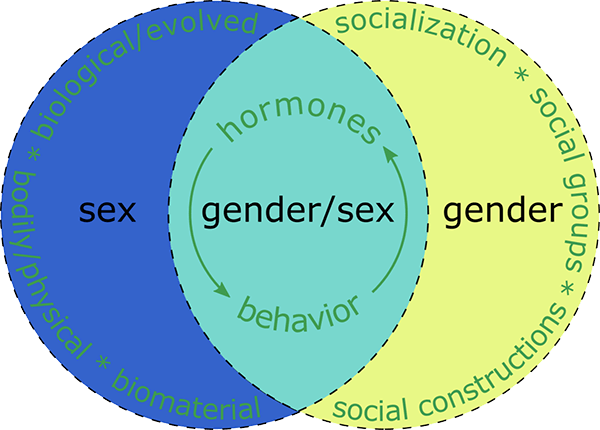
We use the concept of "gender/sex" (van Anders & Dunn, 2009;
van Anders, 2015; van Anders, in press) to
refer to phenomena, features, and whole people where gender and sex
intertwine, could both be relevant, and/or the two cannot be disentangled
easily or at all. Typically, human
biology focuses on sex (femaleness, maleness, maybe
sex-diversity) while sociocultural research focuses on gender
(femininity, masculinity, maybe gender-diversity). Gender/sex
expresses a more empirically accurate entanglement in queer and
scientific terms. We ground our work on gender/sex in
"Sexual Configurations Theory", in part, which Dr. van Anders developed to help
conceptualize this and other phenomena, and provide innovative,
inclusive, feminist, queer, and scientifically meaningful ways
of measuring and addressing gender/sex.
Some relevant papers
on Section Title are:
- van Anders SM, in press.
Gender/Sex/ual diversity and biobehavioral research. Psychology of Sexual Orientation and Gender Diversity.
- De France K, Lucas M, van Anders SM, & Cipriano C, in press.
Measuring gender in elementary school-aged children in the United States: Promising practices and barriers to moving beyond
the binary. American Psychologist.
- Ibrahim A, Clarke J, Beischel W, & van Anders SM, 2024.
Gender/Sex markers, bio/logics, and U.S. identity documents. Feminism & Psychology.
And, here is a one-page accessible summary!
- Beischel WJ, Schudson ZC, Hoskin RA, & van Anders SM, 2024.
The Gender/Sex 3x3: Measuring and categorizing gender/sex beyond binaries.
Psychology of Sexual Orientation and Gender Diversity, 10, 355-372.
-
Beischel WJ, Gauvin SEM, & van Anders SM, 2022. "A little shiny gender
breakthrough:" Community understandings of gender euphoria. International
Journal of Transgender Health, 23, 1-21.
And here is a one-page accessible summary!
- Schudson ZC & van Anders SM, 2022. Gender/sex diversity beliefs:
Scale construction, validation, and links to prejudice. Group Processes &
Intergroup Relations, 25, 1011-1036.
- Beischel WJ, Schudson ZC, & van Anders SM, 2021. Visualizing
gender/sex diversity via sexual configuratiosn theory. Psychology of Sexual
Orientation and Gender Diversity.
-
Abed EC, Schudson ZC, Gunther OD, Beischel WJ, & van Anders SM, 2019.
Sexual and gender diversity among sexual and gender/sex majorities: Insights
via sexual configurations theory. Archives of Sexual Behavior, 48, 1423-1441.
-
Hyde JS, Bigler RB, Joel DS, Tate CC, & van Anders SM, 2019.
The future of sex and gender in psychology: Five challenges
to the gender binary. American Psychologist, 74, 171-193.
DOI:
http://dx.doi.org/10.1037/amp0000307
-
Schudson ZC, Beischel WJ, & van Anders SM, 2019.
Individual variation in gender/sex category definitions.
Psychology of Sexual Orientation and Gender Diversity, 6, 448-460.
-
van Anders SM, Schudson ZC, Abed EC, Beischel WJ, Dibble ER,
Gunther OD, Kutchko VJ, & Silver ER, 2017. Biological sex,
gender, and public policy. (Invited contribution.) Policy
Insights from the Behavioral and Biological Sciences, 4,
194-201.
-
Schudson ZC, Dibble ER, & van Anders SM, 2017. Gender/Sex
and sexual diversity via Sexual Configurations Theory:
Insights from a qualitative study with gender and sexual
minorities. Psychology of Sexual Orientation and Gender
Diversity, 4, 422-437.
-
van Anders SM, 2015. Beyond sexual orientation: Integrating
gender/sex and diverse sexualities in Sexual Configurations
Theory. Archives of Sexual Behavior, 44, 1177-1213.
-
van Anders SM, 2014. 'Bio/logics'. Transgender Studies
Quarterly, 1 Inaugural Issue: Postposttransexual; Terms for
a 21st Century Transgender Studies, 33-35.
-
van Anders SM, 2013. Invited contribution: Beyond
masculinity: Testosterone, gender/sex, and human social
behavior in a comparative context. Frontiers in
Neuroendocrinology, 34, 198-210.
Sexual Diversity
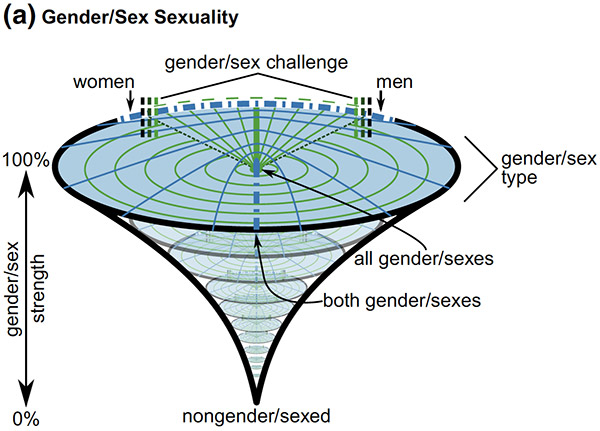
Our research focuses on sexuality broadly understood,
and we attend to individuals from sexual majority and sexual
minority groups. To do so, we aim to avoid (further)
marginalizing those from minoritized groups. We are interested
in a host of sexual and relational diversity, including
gender/sex sexualities (e.g., LGB & heterosexuality) and partner
number sexualities (e.g., polyamory, monosexuality, asexuality).
A major thrust of this work involves "Sexual Configurations
Theory" (SCT; van Anders, 2015). Our goal with SCT is to
conceptualize and model diverse gender/sexes and partnered
sexualities that are built from lived experiences (especially on
the sexual margins) and relevant to people's lives. To do so, we
crafted our award-winning interdisciplinary framework in ways
that incorporate feminist/queer scholarship and bioscience. SCT
addresses gender/sex sexuality and partner number sexuality,
solitary and partnered sexuality, eroticism and nurturance, as
well as branchedness and coincidence. It uses what we call a
"sexual diversity lens" to do so. We have developed materials about
SCT to make it more accessible to people, including researchers,
clinicians, and educators.
Some relevant papers
on Section Title are:
- van Anders SM, in press.
Gender/Sex/ual diversity and biobehavioral research. Psychology of Sexual Orientation and Gender Diversity.
- van Anders SM, Beischel WJ, Schudson ZC, & Chadwick SB, in press. Gender, sex, and sexuality in Psychology:
Principles of feminist and queer science. Psychology of Sexual Orientation and Gender Diversity.
- Burns JA, Beischel WJ, & van Anders SM, 2024. Hormone
therapy and trans sexuality. Psychology of Sexual Orientation and
Gender Diversity, 11, 17-30.
-
Abed EC, Schudson ZC, Gunther OD, Beischel WJ, & van Anders
SM, 2019. Sexual and gender diversity among sexual and
gender/sex majorities: Insights via sexual configurations
theory. Archives of Sexual Behavior, 48, 1423-1441.
-
Schudson ZC, Manley MM, Diamond LM, & van Anders SM, 2018.
Heterogeneity in gender/sex sexualities: Gendered physical
and psychological traits in attractions to women and men.
Journal of Sex Research. DOI:
http://dx.doi.org/10.1080/00224499.2017.1402290
-
Schudson ZC, Dibble ER, & van Anders SM, 2017. Gender/Sex
and sexual diversity via Sexual Configurations Theory:
Insights from a qualitative study with gender and sexual
minorities. Psychology of Sexual Orientation and Gender
Diversity, 4, 422-437.
-
van Anders SM, 2015. Beyond sexual orientation: Integrating
gender/sex and diverse sexualities in Sexual Configurations
Theory. Archives of Sexual Behavior, 44, 1177-1213.
-
Manley MH, Diamond LM, & van Anders SM, 2015. Polyamory,
monoamory, and sexual fluidity: A longitudinal study of
identity and sexual trajectories. Psychology of Sexual
Orientation and Gender Diversity, 2, 168-180.
-
van Anders SM, 2015. Beyond sexual orientation: Integrating
gender/sex and diverse sexualities in Sexual Configurations
Theory. Archives of Sexual Behavior, 44, 1177-1213.
-
van Anders SM, 2012. From one bioscientist to another:
Guidelines for researching and writing about bisexuality for
the lab and biosciences. Journal of Bisexuality, 12, 393-403
-
van Anders SM, 2009. Androgens and diversity in adult human
partnering. Chapter 15 In PB Gray & PT Ellison (Eds.)
Endocrinology of Social Relationships. Harvard University
Press: Cambridge, MA.
Sexuality

Our research in sexuality involves in-depth explorations of
various sexual phenomena, like cuddling, orgasm, fantasy,
solitary sexuality, arousal, thoughts, visual stimuli, jealousy,
and desire. Sometimes sometimes our research
focuses only on the sexual phenomena themselves; other times, we examine how these
phenomena are linked to, or modulate, testosterone and other
hormones (as based in the S/P Theory). Some of our
main interests include multifaceted sexual desire, and how
desire can be experienced in different ways - not just amounts -
by different people or at different times. This helps us
understand desire as well as hormone-desire links. We are also
interested in understanding how culture, gender norms, and
physiology mutually or exclusively relate to sexuality,
including how some aspects of sexuality widely assumed to be
hormonal might actually be better understood with or alongside
a sociocultural lens. Much of our newer work is rooted in our
"Heteronormativity Theory of Low Sexual Desire in Women Partnered
with Men", which articulates that heteronormativity (inequitable gender roles
tied to expectations of heterosexuality) might actually better account for
low desire in women than other accounts that define it as a problem, and one that
resides within women, and especially their bodies.
Some relevant papers
on Section Title are:
- Gormezano AM & van Anders SM, in press. Sexual norms across pornography use, sexual fantasy, and in-person sexuality.
Archives of Sexual Behavior.
- van Anders SM, in press.
Gender/Sex/ual diversity and biobehavioral research. Psychology of Sexual Orientation and Gender Diversity.
- van Anders SM, Beischel WJ, Schudson ZC, & Chadwick SB, in press. Gender, sex, and sexuality in Psychology:
Principles of feminist and queer science. Psychology of Sexual Orientation and Gender Diversity.
- Burns JA, Beischel WJ, & van Anders SM, 2024. Hormone therapy and trans
sexuality. Psychology of Sexual Orientation and Gender Diversity, 11, 17-30.
- Gormezano AM, Harris AM, Gauvin SEM, Pinto J, van Anders G, & van Anders SM, 2022.
Sexual orientation across porn use, sexual fantasy, and in-person sexuality: Visualizing
branchedness and coincidence via Sexual Configurations Theory. Archives of Sexual
Behavior, 51, 1201-1219.
- Harris EA, Gormezano AM, & van Anders SM, 2022.
Gender inequities in household labor predict lower desire in women partnered with men.
Archives of Sexual Behavior, 51, 3847-3870.
- van Anders SM, Herbenick D, Brotto LA, Chadwick SB, & Harris EA, 2022.
The heteronormatvity theory of low sexual desire in women partnered with men.
Archives of Sexual Behavior, 51, 391-415.
-
Chadwick SB, Francisco M, & van Anders SM, 2019. When
orgasms do not equal pleasure: Accounts of “bad” orgasm
experiences during consensual sexual encounters. Archives of
Sexual Behavior, 48, 2435-2459.
-
Chadwick SB, Raisanen JC, Goldey KL, & van Anders SM, 2018.
Strategizing to make pornography worthwhile: A qualitative
exploration of women’s agentic engagement with sexual media.
Archives of Sexual Behavior, 47, 1853-1868.
-
Raisanen JC, Chadwick SB, Michalak N, & van Anders SM, 2018.
Average associations between sexual desire, testosterone,
and stress in women and men over time. Archives of Sexual
Behavior, 47, 1613-1631.
-
Chadwick SL, Burke SB, Goldey KL, Bell SB, & van Anders SM,
2017. Sexual desire in sexual minority and majority women
and men: The multifaceted sexual Desire Questionnaire
(DESQ). Archives of Sexual Behavior, 46, 2465-2484.
-
Chadwick SB & van Anders SM, 2017. Do women's orgasms
function as a masculinity achievement for men? Journal of
Sex Research, 54, 1141-1152.
-
Goldey KL, Posh AR, Bell SN, & van Anders SM, 2016. Defining
pleasure: A focus group study of solitary and partnered
sexual pleasure in queer and heterosexual women. Archives of
Sexual Behavior, 45, 2137-2154.
-
Goldey KL & van Anders SM, 2015. Sexual modulation of
testosterone: Insights for humans from across species.
Adaptive Human Behavior and Physiology, 1, 93-123.
-
Goldey KL, Avery LR, & van Anders SM, 2014. Sexual fantasies
and gender/sex: Integrating quantitative content analysis
and hormonal responses. Journal of Sex Research, 51,
917-931.
-
van Anders SM, Hipp LE, & Kane Low L, 2013. Exploring
co-parent experiences of sexuality in the first three months
after birth. Journal of Sexual Medicine, 10, 1988-1999.
-
van Anders SM, 2012. Testosterone and sexual desire in
healthy women and men. Archives of Sexual Behavior, 41,
1471-1484.
-
Goldey KL & van Anders SM, 2011. Invited Contribution: Sexy
thoughts: Effects of sexual cognitions on arousal and
hormones. Hormones and Behavior, Special Issue: Research on
Sexual Arousal, 59, 754-764.
Social Neuroendocrinology
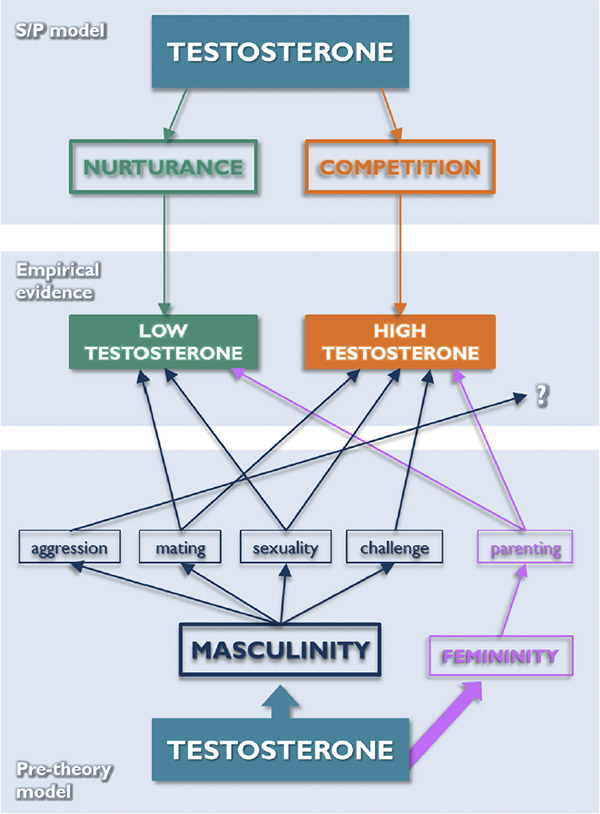
What might bioscience, built with feminist and queer commitments
from the ground up, look like? One of our main contributions is
to social neuroendocrinology, a field we helped kick-start in
2006 (van Anders & Watson, 2006). Social neuroendocrinology
is the study of hormones-behaviour associations in social context.
This attends to people as socially located instead of interchangeable bodies.
It also attends to behaviours as multifaceted and socially situated rather
than unitary and universal actions. And, we explore evolutionary processes
(in humans) as cross-species and human-specific when appropriate.
Social neuroendocrinology not only reverses the arrow of causality
(from just hormones -> behavior to, additionally,
behavior -> hormones) but provides models for studying
iterative, recursive, and dynamic associations between hormones
and behavior in whole people who reflect evolutionary and
socially constructed processes.
Our research helps to provide ways to do socially situated
science that are biologically expansive (not reductionist), biolegible
(i.e., to other bioscientists), and informed by lived experiences
(critically reflective narratives of the minoritized and
marginalized).
We focus on social modulation of testosterone. Our work explores the social phenomenology of
testosterone (what is its evolved social function?) as well as
behavioural contexts tied to intimacy, sexuality, nurturance, and partnering/pair
bonding. We are aso interested in the sequelae (effects) of socially
modulated hormones, including on health and immunity.
We ask hormonal questions that have both evolution and social
construction in their answers. To do so, we developed the
award-winning Steroid/Peptide Theory of Social Bonds (S/P
Theory; van Anders et al., 2011). This highlights how testosterone
is linked, not to maleness/masculinity, but to competition and
nurturance regardless of gender/sex. The S/P Theory is not
post-gender though: gender constrains and influences how
competition (acquiring or defending resources, e.g., status,
sexual opportunities, power) and nurturance (warm, supporting,
and/or loving contact with others, e.g., partners, children,
pets) are experienced, as do a host of intersecting identities.
Some relevant papers
on Social Neuroendocrinology
are:
-
van Anders SM, in press. Gender/Sex/ual diversity & biobehavioral research.
Psychology of Sexual Orientation and Gender Diversity.
-
van Anders SM, Steiger J, & Goldey KL, 2015. Gendered
behavior modulates testosterone in women and men. PNAS:
Proceedings of the National Academy of Sciences, 112,
13805-13810.
-
van Anders SM, Goldey KL, & Bell SN, 2014. Measurement
of testosterone in human sexuality research: Methodological
considerations. Archives of Sexual Behavior, 43, 231-250.
-
van Anders SM, 2013. Invited contribution: Beyond
masculinity: Testosterone, gender/sex, and human social
behavior in a comparative context. Frontiers in
Neuroendocrinology, 34, 198-210.
-
van Anders SM, Goldey KL, & Kuo PX, 2011. Invited Expert
Review: The Steroid/Peptide Theory of Social Bonds:
Integrating testosterone and peptide responses for
classifying social behavioral contexts.
Psychoneuroendocrinology, 36, 1265-1275. (Winner of the Ira
& Harriet Reiss Theory Award from the Foundation for the
Scientific Study of Sexuality, FSSS.)
-
van Anders SM & Watson NV, 2006. Social
neuroendocrinology: Effects of social contexts and
behaviours on sex steroids in humans. Human Nature, 17(2),
212-237.

